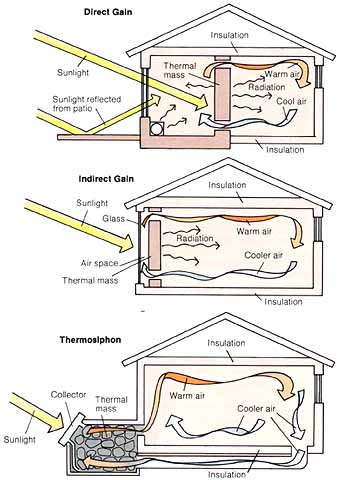Passive solar heating systems distribute solar heat as a natural extension of their collecting and storing properties. Such a system makes use of the sun’s heat falling directly on a south-facing collector, which can be faced with glass or ultraviolet-resistant plastic. Passive solar systems use structural design to increase solar collection in winter and reduce it in summer. These systems use many south-facing windows, and have overhangs and awnings for shade in the hot summer months. The design of the house and placement of collection/storage elements are all-important.
• Direct gain systems: Certain passive systems are said to be direct gain systems when they use the sun’s heat without deflection or interference, and when collection, storage, and distribution all occur within the same space. In these systems, the space itself is heated directly by sunlight, and components of that space absorb, store, and distribute the heat. In general, such a system includes many south-facing windows, and a large mass within the space, placed to receive the most direct sunlight in cold weather and the least direct sunlight in hot weather. Typically, such a mass is made of a specific material that has the ability to collect, store, and distribute heat—for example, floors and /or walls of masonry, stone, or concrete, such as the adobe houses common to the American Southwest. Or sometimes this mass may be water, contained in drums or cylinders. The mass absorbs solar heat during its day time exposure to direct sunlight, and re radiates that heat back into the space during the cooler night.
• Indirect gain systems: Passive solar systems are said to be indirect gain systems when a thermal mass such as rock or contained liquid stands between the sun and the space to be heated. The mass absorbs the sun’s heat and passes it on to the space.
An indirect gain passive space- heating system may be constructed in a room by adding a thermal mass several inches inside the south-facing window. That mass may be as simple as a collection of glass or plastic jars painted black and filled with water, or as sophisticated as a Trombé wall ducted at the top to permit warm air to pass into the room, and ducted at the bottom to permit cooler air to pass out of the room and back to the heat-collection area. (For more on Trombé wall)
You can also use rock, although its use is likely to be restricted to floors and walls. It’s possible to bind piles of rock in place artistically with mesh wire; but for adequate passive solar space heating you would need about 100 pounds of small (1 - to 4-inch) rocks per square foot of window with the sun shining directly onto the mass.
Thermosiphoning is simply a form of convection. When a wall (with or without drums or tubes for added heat storage) is placed directly behind a south-facing window, the heat is collected and trapped between the window glass and the wall. This heats the air there, which then rises, spilling into the room through vents at the top of the wall. The cooled air returns through vents at the bottom of the wall.
This principle can also be used with flat-plate collectors. Here, the elements normally associated with an active solar system are used in a passive system. In this case, collectors are always set below the storage tanks or bins to take advantage of the natural inclination of air and water to rise when heated and to fall when cooled.

Direct Gain: Sunlight passes through glass, and its
heat is trapped in the room. Several thermal masses absorb the heat—the
masonry floor, a stone window seat, and a stone wall. When the temperature
inside the room becomes less than that of the thermal masses, they release
the heat they stored earlier, keeping the room warm.
Indirect Gain: Sunlight passes through glass, and its heat is trapped in the narrow space between the window and the thick masonry wall. Vents at the top and bottom of the wall permit air to circulate and to heat the room by convection, and the thermal mass absorbs and stores heat for radiation into the room after the sun has gone.
Thermosiphon: Sunlight is absorbed by the collector, and may or may not be stored by a thermal mass such as a rock bin. As the air in the collector or the rock bin warms up, it rises and enters the house through ducts provided for that purpose. As the air cools, it falls, entering return ducts that carry it back to be reheated.
Next: Ways to Heat Your Space with the Sun